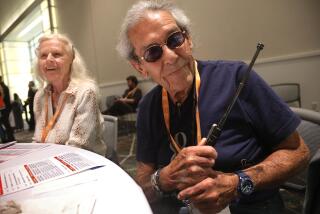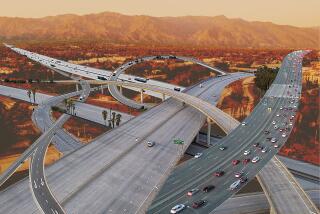Yes, You Can Get There From Here
Nobody relishes the morning commute, and the afternoon haul, well, that just goes without saying. Yet nearly a third of Southern California commuters--31%--say their daily schleps are actually getting better.
That little surprise is contained in the sixth-annual “State of the Commute,” a 134-page tome prepared by the nonprofit Commuter Transportation Services detailing everything everyone ever wanted to know about the region’s commuting habits.
For instance, only 28% of commuters in five counties say they are fairly often or very often bothered by traffic congestion. Maybe that explains why freeway shootings have tapered off in recent years. And a full 24% of Los Angeles County commuters said their trips to work are “always good.”
Who are these people? And why are they so content?
Perhaps it’s because there are fewer commuters heading to work; that’s the speculation of Caltrans and other transit wonks. Since 1990, regional employment has dropped from 6.9 million to 6.6 million, and almost all those job losses have been in Los Angeles County.
Another explanation for this rosy outlook might lie with Darwin. Species evolve. They adapt. Maybe, the traffic doctors theorize, motorists have simply grown accustomed to the pace of their sluggish commute.
While a volume of traffic statistics might seem esoteric bedtime reading, commuting is one of the few things in this modern Babel that passes for a common experience. Each year, Californians spend 1.2 billion--that’s with a b --hours driving in congested traffic.
And as often as the drive is lamented and the taillights ahead are cursed, most commuters follow the same old routine day after day after day, according to the survey of motorists in Los Angeles, Orange, Riverside, San Bernardino and Ventura counties.
Nearly 81% still drive alone.
*
Everybody does it, but everybody does it just a little differently.
Men commute longer than women--72 minutes round-trip contrasted with 60 minutes for women--and farther--18.5 miles each way compared to 14 miles. And men are more likely than women to drive on the freeway--62% to 48%.
Cheryl Collier, research director for Commuter Transportation Services, said such figures reflect the differences between men and women in day to day life.
“People will travel longer distances for greater incomes,” she said. Women on average are paid less than men, so are less likely to drive farther to higher-paying jobs.
Despite their shorter commutes, women are stressed by traffic more than men, Collier said, speculating that it may have something to do with the fact that women’s commutes are generally more complicated.
Roughly 23% of women make multiple stops on their way to work. Although about 21% of men also make stops, their reasons are different. Of women, 53% stop to drop off or pick up a child at school or day care.
Only a quarter as many men--12%--make similar stops. They are more likely to stop to eat, to buy gasoline or to run a work-related errand.
Similar disparities are noted when the commutes of different ethnic groups are compared. While 84% of whites and Asians drive alone to work, roughly 78% of African Americans and 73% of Latinos do.
Not surprisingly, the more money a driver makes, the more likely he or she is to drive alone to work.
For all groups, the average commuting distance is 16.5 miles each way, slightly up from 15 miles last year. Average time to work is 31 minutes. The average drive home is 36 minutes.
Why the discrepancy? More drivers are going more places in the afternoon than in the morning.
*
So why should anyone care that 36% of commuters arrive at work before 7:30 a.m.? Or that 55% leave before 5 p.m., making the rush “hour” run from 4 p.m. to 6:30?
Granted, the numbers won’t even make good barstool trivia. Transportation scholars will take the statistics and try to devise better ways of luring us out of cars and into other forms of transit.
It is harder than it sounds. Almost all of the 2,625 commuters in the survey said they were aware of alternate ways to work.
Yet only 14% carpool, 2% ride the bus and 1% each walk, bicycle or vanpool. The rest have a list of reasons why they can’t leave their car parked for the day.
Damn the congestion, they say, full speed ahead.
“It’s going to take a long time to transition out of this mindset,” Collier said of the love of solo motoring. Traffic will have to worsen for people to change their habits, she added. “If you’re not disgruntled or unhappy, you’re not going to change what you’re doing.”
On the bright side, though, 39% of commuters still say traffic is getting worse. Maybe next year, they’ll be in the carpool lane.
Traffic Views Results of Commuter Transportation Services survey of 2,625 people show more 1994 respondents rate current freeway traffic better than previous year’s. Responses from 1991-94.
1991 1992 1993 1994 Better 11% 12% 19% 31% Same 25% 33% 32% 30% Worse 64% 55% 49% 39%
Source: Commuter Transportation Services
More to Read
Sign up for Essential California
The most important California stories and recommendations in your inbox every morning.
You may occasionally receive promotional content from the Los Angeles Times.









